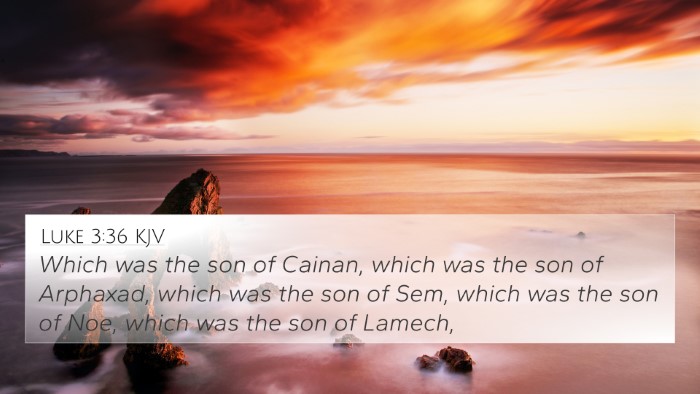Exploring Genesis 11:12
Genesis 11:12 states: "And Arpachshad lived five and thirty years, and begat Salah." This simple genealogical record may seem mundane at first, but it holds profound significance within the narrative of Genesis and the broader biblical message. To develop a comprehensive understanding, we can draw from the insights of biblical commentators such as Matthew Henry, Albert Barnes, and Adam Clarke.
Historical Context
The genealogy found in Genesis is crucial for understanding the lineage of the Israelites. Arpachshad is the son of Shem and a key figure in the ancestry leading to Abraham. This lineage serves a dual purpose: it demonstrates God's covenant promise throughout generations and establishes the historical roots of the Abrahamic faiths.
Insights from Matthew Henry
Matthew Henry in his commentary emphasizes the importance of these genealogies in showcasing God's providence. He notes that each name signifies a link in God's unfolding plan for humanity, particularly in how the lineage eventually leads to Christ. Henry suggests that understanding these connections enriches our appreciation of God's faithfulness across generations.
Insights from Albert Barnes
Albert Barnes expounds on the numerical details, noting that "five and thirty years" signifies a complete period before the birth of Salah. This attention to detail reflects the meticulous structure of biblical genealogies, indicating that God's timing is perfect. Barnes encourages readers to see this as a reminder that God orchestrates events across time, guiding history toward His divine purpose.
Insights from Adam Clarke
Adam Clarke offers a theological perspective, suggesting that the lives of these early figures symbolize spiritual truths. The names and ages can serve as allegorical references to God's blessings and the vitality of faith passed through generations. Clarke notes how tracing these lineages not only affirms our heritage but also reinforces the continuity of God’s covenant with humanity.
Thematic Connections and Cross-References
Genesis 11:12 interacts with several other scripture passages that provide deeper insight and reveal thematic connections:
- Genesis 10:22-24: This passage discusses the descendants of Shem, including Arpachshad, establishing context for Genesis 11:12.
- Luke 3:36: The New Testament genealogy of Jesus traces back to Arpachshad, linking the Old Testament promise to New Testament fulfillment.
- Hebrews 7:14: This verse emphasizes Jesus' lineage from the tribe of Judah, which is a significant development stemming from the lineage initiated in Genesis 11.
- Romans 4:15: The discussion of Abraham and the importance of faith ties back to the lineages established in Genesis.
- 1 Chronicles 1:1-4: This genealogy further confirms the historical significance of Arpachshad in the broader narrative of God's people.
- Isaiah 11:1: Foretelling from the lineage of Jesse (David) connects to the line originating from Shem, showcasing God's redemptive plan.
- Matthew 1:1-16: The genealogy of Jesus demonstrates the fulfillments of promises made to the descendants of Abraham, of whom Arpachshad is a crucial link.
- Acts 7:14-15: Refers to the familial ties of Abraham, affirming the continuation of God's promise to his descendants.
- Exodus 6:16-20: Highlights the importance of genealogy among the Israelites, further emphasizing the significance of these early figures.
- Deuteronomy 10:22: Mentions how the Israelites multiplied, stemming from the early genealogies, including those of Arpachshad and Salah.
Concluding Thoughts
The genealogical details of Genesis 11:12 may appear straightforward, yet they unveil a tapestry of God's grace, faithfulness, and providential steering of history. By examining connections between Bible verses and cross-referencing these texts, we enrich our understanding of Scripture as a unified narrative of God's revelation to humanity. Each lineage speaks to a larger Biblical theme, emphasizing the interconnectedness of God's story from the Old Testament through to the New Testament.



